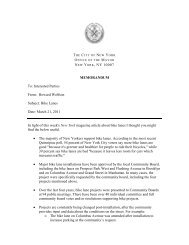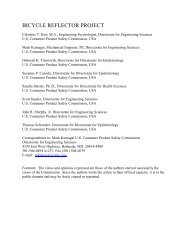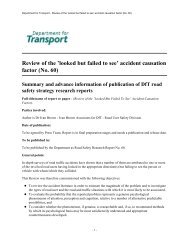Guide for the Development of Bicycle Facilities - The Industrialized ...
Guide for the Development of Bicycle Facilities - The Industrialized ...
Guide for the Development of Bicycle Facilities - The Industrialized ...
Create successful ePaper yourself
Turn your PDF publications into a flip-book with our unique Google optimized e-Paper software.
guide <strong>for</strong> <strong>the</strong> development <strong>of</strong> bicycle facilities 13<br />
travel, and roadway improvements. Facility selection should seek<br />
to maximize user benefits per dollar funded.<br />
❍ State and Local Laws and Ordinances—<strong>Bicycle</strong> programs must reflect<br />
state and local laws and ordinances. <strong>Bicycle</strong> facilities must not<br />
encourage or require bicyclists to operate in a manner that is inconsistent<br />
with <strong>the</strong>se laws and ordinances.<br />
Education Programs <strong>for</strong> Bicyclists and Motorists<br />
Bicyclist and motorist education programs are key ingredients to building<br />
a successful bicycle transportation system and fostering <strong>the</strong> growth <strong>of</strong><br />
bicycle use in a community. A primary reason is <strong>the</strong> great amount <strong>of</strong> misin<strong>for</strong>mation<br />
that has spread about bicycling. Education programs can<br />
help to dispel <strong>the</strong> myths, encourage courteous and lawful behavior<br />
among motorists and bicyclists <strong>of</strong> all ages, and enhance <strong>the</strong> skill level <strong>of</strong><br />
bicyclists and motorist awareness, thus leading to a reduction in crashes.<br />
<strong>The</strong> education program can be administered through a number <strong>of</strong> different<br />
agencies and interest groups, such as police departments, schools,<br />
libraries, bicycle clubs, and parks and recreation departments.<br />
<strong>The</strong>re are four primary audiences <strong>for</strong> bicycle safety education and<br />
awareness ef<strong>for</strong>ts. For each group, an education program can stress basic<br />
messages that focus on <strong>the</strong> most frequent causes <strong>of</strong> crashes and injury.<br />
<strong>The</strong> following represent messages and skills that should be stressed <strong>for</strong><br />
each group:<br />
Young Bicyclists:<br />
❍ How to ride in a straight line without wobbling or swerving<br />
❍ Importance <strong>of</strong> stopping, looking and yielding be<strong>for</strong>e entering or<br />
crossing a roadway<br />
❍ Importance <strong>of</strong> riding with traffic (on <strong>the</strong> right-hand side <strong>of</strong> <strong>the</strong><br />
road), ra<strong>the</strong>r than against traffic<br />
❍ How to scan behind <strong>for</strong> traffic be<strong>for</strong>e moving or turning left<br />
❍ Importance <strong>of</strong> helmet use<br />
❍ Importance <strong>of</strong> using hand signals<br />
❍ Knowledge and understanding <strong>of</strong> traffic control devices<br />
❍ Methods <strong>of</strong> crossing intersections<br />
Parents <strong>of</strong> Young Bicyclists:<br />
❍ Age and developmental factors in bicycle safety<br />
Planning





